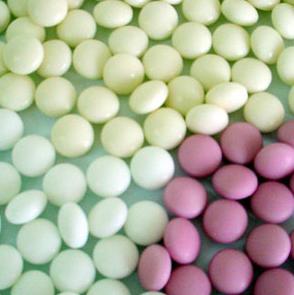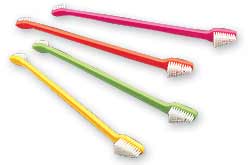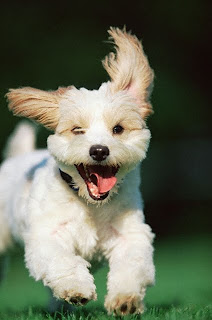Most dogs love food and especially yearn for "people food". After begging and begging, often, owners will let their dogs ‘taste’ the food eventually. However some foods which are edible for humans, and even other species of animals, can pose hazards for dogs because of their different metabolism. Some may cause only mild digestive upsets, whereas, others can cause severe illness, and even death. Knowing what foods to avoid feeding your dog is important, so you can prevent food poisoning on your dog.
Grapes and Raisins
- Grapes and Raisins can cause irreversible damage to the kidneys, possible resulting in death.
- Ingesting as few as 4-5 grapes or raisins can be poisonous to a 20 pound dog, though the exact toxic dose is not established.
- Signs of toxicity include vomiting, loss of appetite, diarrhea, abdominal pain, decreased urine production (possibly leading to lack of urine production), weakness and drunken gait.
- Onset of signs typically occurs within 24 hours (though they can start just a few hours after consumption)
- Your vet may start by inducing vomiting, or the stomach might be pumped (gastric lavage). Treatment involves aggressive supportive care - particularly fluid therapy and medications.
Chocolate
- Chocolate and cocoa contain a chemical called theobromide that can adversely affect the heart, lungs, kidney and central nervous system.
- Pure baking chocolate is most toxic, while milk chocolate requires a higher quantity to cause harm. A 20 pound dog can be poisoned after consuming about 2 ounces of baking chocolate, but it would take nearly 20 ounces of milk chocolate to cause harm. Ingestion of cacao bean mulch can also be toxic.
- Signs include excitement, tremors, seizures, vomiting, diarrhea, abnormal heart rate/rhythm, drunken gait, hyperthermia and coma.
- Your vet may induce vomiting or perform gastric lavage. Treatment includes administration of activated charcoal and aggressive supportive care with fluid therapy and medications.
Xylitol
- Xylitol is a sugar-free sweetener most often found in chewing gum and candy. In dogs, it stimulates the pancreas to secrete insulin, resulting in hypoglycemia (low blood sugar). Xylitol ingestion can also cause severe liver damage.
- As few as two pieces of gum can be hypoglycemia to a 20 pound dog. A pack of gum can cause liver damage.
- Signs of toxicity can occur within 30-60 minutes and include weakness, drunken gait, collapse and seizures.
- Your vet may induce vomiting or perform gastric lavage. The affected dog will likely need to be treated intravenously with dextrose (sugar) and monitored closely for 1-2 days. Many dogs improve with supportive care if treated early enough, though liver damage can be permanent.
Onions
- Onions can cause a form of hemolytic anemia called Heinz body anemia, a condition that causes the destruction of red blood cells. Kidney damage may follow.
- Toxicity may occur from similar foods such as garlic and chives.
- It is not clear what quantity of onions is poisonous, but the effects can be cumulative. Poisoning can result from raw, cooked and dehydrated forms. Avoid feeding table scraps and any foods cooked with onions (including some baby foods). Check your ingredients!
- Signs are secondary to anemia, such as pale gums, rapid heart rate, weakness and lethargy. Other signs include vomiting, diarrhea, and bloody urine.
- Treatment: blood transfusions and/or oxygen administration may be necessary, followed by specific fluid therapy.
Caffeinated Items
- Caffeine is quite similar to the toxic chemical in chocolate. It can damage the heart, lungs, kidney and central nervous system.
- Commons sources of toxicity include caffeine pills, coffee beans and coffee, large amounts of tea, and chocolate.
- Signs typically begin with restlessness, hyperactivity and vomiting. These can be followed by panting, weakness, drunken gait increased heart rate, muscle tremors and convulsions.
- Your vet may induce vomiting or perform gastric lavage. Treatment includes administration of activated charcoal and supportive care with fluid therapy and medications.
Alcohol and Yeast Dough
- Alcoholic beverages contain ethanol - a seriously toxic chemical compound that causes central nervous system and respiratory depression.
- Uncooked yeast dough also produce ethanol.
- Even small amounts of ethanol can cause toxic effects.
- Signs include sedation, depression, lethargy, weakness, drunken gait and hypothermia (low body temperature).
- Ethanol is rapidly absorbed into the system, so it is important to seek medical attention quickly. It is not usually helpful to induce vomiting. Treatment includes aggressive supportive care with fluid therapy and medications.
- Under controlled circumstances, alcohol is used by veterinarians as an antidote for antifreeze (ethylene glycol) poisoning.
Macadamia Nuts
- Macadamia nuts, while generally not considered fatal, can cause your dog to experience severe illness.
- The actually toxin is not know, nor is the mechanism of toxicity.
- Ingestion of just a handful of nuts can cause adverse effects in any dog.
- Signs include vomiting, weakness, depression, drunken gait, joint/muscle pain, and joint swelling.
- Onset of signs typically occurs within 6-24 hours.
- Dogs are typically treated symptomatically and recover within 24-48 hours. In-hospital supportive care may be recommended for dogs that become very sick.
Fruit Pits and Seeds
- Apple seeds, cherry pits, peach pits, and plum pits contain the toxin cyanide.
- Signs of cyanide poisoning include vomiting, heavy breathing, apnea tachycardia, cardiac arrhythmias, coma, and skin irritation.
- In some cases, antidotes are available. Other treatments include oxygen therapy, fluids and supportive care.
- Also take note that the leaves, fruit, seeds and bark of avocados contain Persin, which can cause vomiting and diarrhea in dogs. Also, the fat content is not healthy for dogs.
Rotten or Moldy Foods
Moldy or rotten foods can cause many problems for your dog, some more serious than others. Any food that seems "past its prime" should be kept out reach. Be especially careful to keep your dog away from trash cans.
- Botulism, often from garbage, can cause paralysis, slow heart rate, constipation, and urine retention. An antitoxin is effective only if poisoning is caught early enough.
- Rotten fruit produces ethanol, causing the same effects associated with alcohol or dough ingestion.
- Moldy foods contain toxins that may cause muscle tremors, convulsions and drunkenness.
- Therapy depends on the toxin. Your vet may induce vomiting. Sometimes, treatment includes activated charcoal. Supportive care with fluids and medications is often necessary.
Other Foods to Avoid
Certain foods, while not considered toxic, can still be unhealthy for your dog. Avoid any foods that are high in fat, sugar or sodium. These foods can contribute to indigestion, obesity, dehydration, electrolyte imbalance and more. Dairy products may be difficult for dogs to digest. Corn cobs and bones can cause GI obstruction. Cooked bones may splinter and break easily, risking GI damage.
Like people, too much junk food can cause poor condition and decreased energy. Remember that your dog is smaller than you and may be sensitive. What seems like "just a bite" for you is more like a small meal for your dog. If you want to feed homemade food, seek advice from your vet. You may wish to meet with a nutritionist for diet recommendations.
(Article from About.com)






















